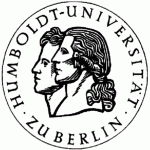 |
 |
 |

 |
 |
 |
| Duration: | October 2003 - May 2006 |
| Project directors: | Prof. Dr. R. März, Prof. Dr. W. Römisch |
| Department of Mathematics, Humboldt-Universität zu Berlin, Unter den Linden 6, 10099 Berlin, Germany | |
| Tel: +49 (0)30 - 2093 2353 (secretary) / - 2093 2861 (office März) / - 2093 2561 (office Römisch) | |
| email: maerz@mathematik.hu-berlin.de, romisch@mathematik.hu-berlin.de | |
| Responsible: | Dr. Renate Winkler, Humboldt-Universität Berlin, Tel: 030 - 2093 5448 / Sekr. 2353 , |
| email: winkler@mathematik.hu-berlin.de | |
| Cooperation: | Infineon Technologies AG München |
| Support: | DFG Research Center "Mathematics for Key Technologies" |
This project is concerned with the analysis and development of
numerical methods for SDAEs as they arise in transient noise analysis
in circuit
simulation. There, thermal noise of resistors as well as shot
noise of semiconductors is modelled by additional sources of additive
or multiplicative Gaussian white noise currents that are shunt in
parallel to the ideal, noise-free elements. Typical circuit
simulation
models form specially structured nonlinear SDAEs of index 1 or 2, which
contain a large number of equations as well as of small
noise
sources. Recognizing their special DAE- structure is crucial for stable
and efficient simulations even in the deterministic case.
In this application one is interested in solution paths, since they
supply more insight in characteristics like the phase-noise than only
the time-evaluation of the distribution of the solution can do.
Therefore the strong solution concept is applied.
Initiated by the industrial partners at Infineon AG , first results
concerning the analysis and simulation of SDAEs have been
achieved in the
past. In particular, the existence and uniqueness of solutions as well
as stability, consistency and convergence of certain
drift-implicit schemes have been proven for SDAEs of index~1 with
noisefree constraints [9-12].
In this project we aim at an analysis of
SDAEs of index~2 and the development of suitable numerical
schemes with higher deterministic order including error-estimation and
stepsize-control.
Structural analysis of index
2 Ito- SDAEs :
Index 2 DAEs are characterized by hidden constraints and
differentiation tasks. A theoretical decoupling of index 2 SDAEs
in its qualitatively different parts forms the basis of an
understanding of such problems. Here, it is essential to find constant transformations that are
compatible with the Ito-calculus. This can be done
using structural properties given in circuit
simulation. Using the charge-oriented version of the modified nodal
analysis is essential for a problem-adapted stable numerical simulation
as is shown in [13-16] for
deterministic circuit models.
Integration schemes:
Schemes that are specially suited for SDAEs with a large number of small noise sources and low smoothness of the
coefficients are needed. In particular, stochastic versions of those
order 2 schemes are of interest that are well established in
deterministic circuit simulation. There, the BDF-schemes are widely
used. As they are multi-step schemes, they only need one evaluation of
the residuum per Newton-step. A convergence analysis of multi-step
schemes for SDEs is done in [3].
Introducing the concepts of stability, consistency und convergence for
multi-step schemes for SDEs in a suitable way we related local and
global errors. This formed the basis for the analysis of local errors
and lead to suitable proposals for schemes in case of small noise [3,4,5]. Moreover, an analysis of
the
asymptotic stability properties of two-step schemes for
SDEs [6], and a
generalization of
the convergence analysis to stochastic delay equations [7] has been done. The
implementation of
the two-step BDF-Maruyama-scheme for SDAEs in circuit simulation
is presented in [8].
Error-estimation and stepsize-control:
Based on the concepts of local and global errors for one-step schemes [10,11] a stepsize-control for the
family of Euler-Maruyama-schemes has been
developed [1]. The mean square
of local errors is
estimated by means of a number of simultaneously computed paths, which
leads to an adaptive stepsize-sequence that is identical for all
paths. Exploiting the smallness of the noise and looking at stepsizes
that are not asymptotically small, a derivative-free realization of
this stepsize-control has been presented and implemented. First steps
towards a generalization to multi-step schemes with deterministic order
2 for small noise SDEs and SDAEs are taken in [2].
| [1] |
W. Römisch and R. Winkler: Stepsize control for mean-square numerical methods for stochastic differential equations with small noise, SIAM J. Sci. Comp. 28 (2006), 604-625. |
| [2] |
T. Sickenberger, E.
Weinmüller and R. Winkler: Local error estimates for moderately smooth problems: Part I - ODEs and DAEs, BIT Numerical Mathematics (to appear). |
| [3] |
E. Buckwar and R. Winkler: Multi-step methods for SDEs and their application to problems with small noise, SIAM J. Num. Anal. 44 (2006), 779-803. |
| [4] |
E. Buckwar and R.Winkler: On two-step schemes for SDEs with small noise, PAMM, vol. 4 (1), 15-18, 2004. |
| [5] |
E. Buckwar and R. Winkler: Improved linear multi-step methods for stochastic ordinary differential equations, J. Comp. Appl. Math. (to appear) |
| [6] |
E. Buckwar, R. Horvath Bokor and
R. Winkler: Asymptotic mean-square stability of two-step methods for stochastic ordinary differential equations, BIT Numerical Mathematics 46 (2006), 261-282. |
| [7] |
E. Buckwar and R. Winkler: Multi-step Maruyama methods for stochastic delay differential equations, Preprint 04-15, Institut für Mathematik, Humboldt-Universität Berlin, 2004. |
| [8] |
R.Winkler: Stochastic differential algebraic equations in transient noise analysis, Springer Series 'Mathematics in Industry' ,Proceedings of 'Scientific Computing in Electrical Engineering', September, 25th - 9th, 2004, Capo D'Orlando, to appear. |
| [9] |
G. Denk and R.Winkler: Modeling and simulation of transient noise in circuit simulation, Proceedings of 4th MATHMOD, Vienna, Feb. 5-7, 2003, to appear in: Mathematical and Computer Modelling of Dynamical Systems (MCMDS). |
| [10] |
W. Römisch and R. Winkler: Stochastic DAEs in circuit simulation, in: Modeling, Simulation and Optimization of Integrated Circuits (K. Antreich, R. Bulirsch, A. Gilg and P. Rentrop eds.), Birkhäuser, Basel 2003, 303-318. |
| [11] | R. Winkler: Stochastic differential algebraic equations of index 1 and application in circuit simulation. J. Comp. Appl. Math. 157 (2003), 477-505. |
| [12] | R. Winkler: Stochastic DAEs in transient noise simulation., Springer Series 'Mathematics in Industry' ,Proceedings of 'Scientific Computing in Electrical Engineering', June, 23rd - 28th, 2002, Eindhoven, 408-415. |
| [13] |
I. Higueras,
R. März, and C. Tischendorf. Stability preserving integration of index-1 DAE's. Appl. Numer. Math., 45(2-3):175-200, 2003. |
| [14] |
I. Higueras,
R. März, and C. Tischendorf. Stability preserving integration of index-2 DAEs. Appl. Numer. Math., 45(2-3):201-229, 2003. |
| [15] |
R. März. Differential-algebraic systems with properly stated leading term and MNA equations. In K. Anstreich, R. Bulirsch, A. Gilg, and P. Rentrop, editors, Modelling, Simulation and Optimization of Integrated Circuits, pages 135-151. Birkhäuser, 2003. |
| [16] |
R. März. Characterizing differential algebraic equations without the use of derivative arrays. Comput. Math. Appl., 50(7):1141-1156, 2005. |